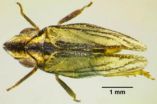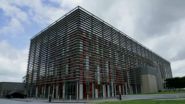(Press-News.org) Led by Dr. Zahoor A. Shah, Dr. Shadia E. Nada and Jatin Tulsulkar (graduate student), researchers at the University of Toledo, Toledo, OH, have discovered that mice treated with Ginkgo biloba 4 hours after inducing experimental stroke and then daily for seven days had improved recovery and less brain damage than the control mice. It was also observed that Ginkgo biloba treated mice had enhanced neurogenesis, partly due to the increased protein expression of hemeoxygenase 1, an antioxidant gene that also has a role in neurogenesis. Pertinently, mice lacking the hemeoxygenase 1 gene were observed to have reduced neurogenesis after stroke.
Besides prevention, improving recovery following a stroke should become the prime focus of current stroke research. We now know that neurogenesis is not only an ongoing process in adults, but can also be induced by pathological conditions like traumatic brain injury and ischemic stroke, and strategies that promote endogenous neurogenesis as part of repair and regeneration process should be prioritized. Neurogenesis in the adult brain involves not only the proliferation and migration of precursor cells known as stem cells/neural progenitor cells (NSCs) but also their functional integration into the neural network. Ischemia, though a potent inducer of proliferation and migration of NSCs, does not provide an environment conducive to their survival, differentiation and integration, and creating an environment with exogenous drugs is paramount to improving the number of NSCs that can result in improved brain repair and regeneration.
The study, first reported in Molecular Neurobiology (Vol. 49, 2014) and then reviewed in Neural Regeneration Research (Vol. 9, No.11, 2014), confirmed that Ginkgo biloba, in addition to its antioxidant, neuritogenic and angiogenic properties, provides a conducive environment for the survival and functional integration of NSCs into neural system.
"Controversies and other ethical issues related to stem cell therapies make drug-induced enhanced neurogenesis a promising treatment strategy," stressed senior author Zahoor A. Shah. "Besides one documented clinical trial recommending the use of Ginkgo biloba after ischemic stroke, further high quality and large-scale randomized controlled trials are warranted to test its efficacy in stroke recovery" he said.
INFORMATION:
Article: "Repair and regeneration properties of Ginkgo biloba after ischemic brain injury" by Aparna Raghavan, Zahoor A. Shah (Department of Medicinal and Biological Chemistry, College of Pharmacy and Pharmaceutical Sciences, University of Toledo, Toledo, Ohio, USA)
Raghavan A, Shah ZA. Repair and regeneration properties of Ginkgo biloba after ischemic brain injury. Neural Regen Res. 2014;9(11):1104-1107.
Contact: Meng Zhao
eic@nrren.org
86-138-049-98773
Neural Regeneration Research
http://www.nrronline.org/
Ginkgo biloba enhances neurogenesis and improves recovery following a stroke in mice
2014-07-22
ELSE PRESS RELEASES FROM THIS DATE:
Fires are a major cause of wind farm failure, according to new research
2014-07-22
*** UPDATE TO NEWS RELEASE: 'Fires are a major cause of wind farm failure, according to new research' ***
Message to news release subscribers from Imperial College London Press Office:
Following discussion with reporters we wish to draw attention to further information relating to the News Release issued under embargo for Thursday 17 July 2014: "Fires are a major cause of wind farm failure, according to new research". A version of this note will be appended to the online news release and news story and both will be updated accordingly.
1. The purpose of the research ...
Cleveland Clinic researchers discover neuroprotective role of immune cell
2014-07-22
July 22, 2014, Cleveland: A type of immune cell widely believed to exacerbate chronic adult brain diseases, such as Alzheimer's disease and multiple sclerosis (MS), can actually protect the brain from traumatic brain injury (TBI) and may slow the progression of neurodegenerative diseases, according to Cleveland Clinic research published today in the online journal Nature Communications.
The research team, led by Bruce Trapp, PhD, Chair of the Department of Neurosciences at Cleveland Clinic's Lerner Research Institute, found that microglia can help synchronize brain firing, ...
High school lacrosse players at risk of concussions other injuries
2014-07-22
AURORA, Colo. (July 22, 2014) – With over 170,000 students now playing high school lacrosse, more and more are being exposed to injuries during practice and competition, according to a new study from the Colorado School of Public Health and the Center for Injury Research and Policy at Nationwide Children's Hospital in Columbus, Ohio.
The study, published online today by The American Journal of Sports Medicine, found that high school lacrosse players experienced 1,406 injuries over the four academic years from 2008 through 2012. The overall injury rate was 20 per 10,000 ...
New planthopper species found in southern Spain
2014-07-22
Not much is known about the the genus of planthopper known as Conosimus, which now includes six species after a new one was recently discovered in the southern part of the Iberian Peninsula in the Spanish city of Jaen. A description of it appears in the open-access Journal of Insect Science (see http://www.insectscience.org/14.92/).
The new species, Conosimus baenai, has been named after Manuel Baena, a Spanish hemipterologist, for his contributions to the taxonomy of Iberian Hemiptera.
Conosimus baenai differs in appearance from the other species in the Conosimus genus ...
Middle East Respiratory Syndrome coronavirus detected in the air of a Saudi Arabian camel barn
2014-07-22
Saudi Arabian researchers have detected genetic fragments of Middle East Respiratory Syndrome coronavirus (MERS-CoV) in the air of a barn holding a camel infected with the virus. The work, published this week in mBio®, the online open-access journal of the American Society for Microbiology, indicates that further studies are needed to see if the disease can be transmitted through the air.
MERS, a serious viral respiratory illness caused by the coronavirus, has been identified in 699 people as of June 11, according to the World Health Organization; 209 people have died ...
Viral therapy could boost limb-saving cancer treatment
2014-07-22
Viruses designed to target and kill cancer cells could boost the effectiveness of chemotherapy to the arms and legs and help avoid amputation, a new study reports.
Scientists at The Institute of Cancer Research, London, tested the effectiveness of a genetically engineered version of the virus used to vaccinate against smallpox.
They found use of the virus alongside isolated limb perfusion chemotherapy – given directly to blood vessels supplying the affected arm or leg as an alternative to amputation – was more effective in rats than either treatment on its own.
The ...
New study finds high school lacrosse players at risk for concussions, other injuries
2014-07-22
Lacrosse is one of the fastest-growing high school sports in the United States, with more than 170,000 students now playing the sometimes hard-hitting game. The growing participation numbers, however, mean that more young people than ever are at risk of injury in lacrosse practice and competition.
In a study published online today by The American Journal of Sports Medicine and available in an upcoming print issue, researchers from the Center for Injury Research and Policy at Nationwide Children's Hospital and the Colorado School of Public Health found that high school ...
Schizophrenia's genetic 'skyline' rising
2014-07-22
The largest genomic dragnet of any psychiatric disorder to date has unmasked 108 chromosomal sites harboring inherited variations in the genetic code linked to schizophrenia, 83 of which had not been previously reported. By contrast, the "skyline" of such suspect variants associated with the disorder contained only 5 significant peaks in 2011. By combining data from all available schizophrenia genetic samples, researchers supported by the National Institutes of Health powered the search for clues to the molecular basis of the disorder to a new level.
"While the suspect ...
Largest gene discovery 'kick-starts' new search for schizophrenia treatments
2014-07-22
VIDEO:
Largest gene discovery helps 'kick-start' new search for schizophrenia treatments - The discovery of over a hundred genetic risk factors linked to schizophrenia provides vital new clues in understanding what...
Click here for more information.
The discovery of over a hundred genetic risk factors linked to schizophrenia provides vital new clues in understanding what causes the condition and will kick-start the search for new treatments, according to leading UK scientists. ...
International team sheds new light on biology underlying schizophrenia
2014-07-22
July 21, 2014 (Toronto) – As part of a multinational, collaborative effort, researchers from Canada's Centre for Addiction and Mental Health (CAMH) have helped identify over 100 locations in the human genome associated with the risk of developing schizophrenia, in what is the largest genomic study published on any psychiatric disorder to date. The findings, published online in Nature, point to biological mechanisms and pathways that may underlie schizophrenia, and could lead to new approaches to treating the disorder, which has seen little innovation in drug development ...


